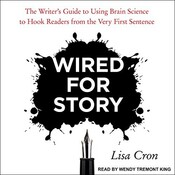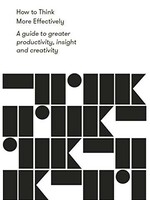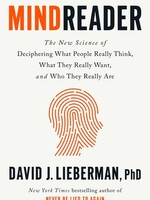
Wired for Story - Book Summary
The Writer's Guide to Using Brain Science to Hook Readers from the Very First Sentence
Release Date: November 11, 2023
Book Author: Lisa Cron
Category: Communication Skills
Release Date: November 11, 2023
Book Author: Lisa Cron
Category: Communication Skills
In this episode of "20 Minute Books", we dive deep into "Wired for Story" by Lisa Cron. This intriguing piece, penned by an accomplished author and literary consultant, uses the groundbreaking findings from modern neuroscience to decode the elements that make a story truly captivating.
"Wired for Story", published in 2012, isn't just an ordinary guide to storytelling. It masterfully bridges the gap between the art of writing and the science of the human brain, explaining why certain narratives enthrall us, while others barely hold our attention. Cron equips writers with fundamental techniques gleaned from this understanding of human neurology, empowering them to craft narratives that are compelling and engaging in every sense.
With her rich professional background as a literary consultant for UCLA Extension Writers' Program, a publisher at W. W. Norton, a literary agent at Angela Rinaldi Literary Agency, and a story consultant for Warner Bros, Lisa Cron brings a unique perspective to the art and science of storytelling.
"Wired for Story" is a must-read for anyone interested in writing, brain science, or storytelling. Whether you're a budding novelist seeking to make your mark, or a seasoned writer yearning to take your craft to the next level, or a curious reader fascinated by the intricate relationship between neuroscience and storytelling, this book is for you. So join us as we explore the core of engaging narratives and the science that makes them unforgettable, all within the span of this 20-minute episode.
The allure of storytelling: Leveraging neuroscience to craft captivating narratives.
The allure of a compelling tale is universal and timeless, an integral part of our human experience. From ancient poets to contemporary authors, the art of storytelling has forever been a pursuit of passion. Yet, modern storytellers possess an unprecedented advantage — the exciting discoveries of neuroscience.
Delving deep into the human brain reveals the secrets behind our affinity for good stories, illuminating the kinds of narratives that captivate our interest most effectively. This exploration is a valuable treasure trove for aspiring authors, offering guidelines that can steer their storytelling endeavors toward success.
In this fascinating journey, you'll uncover:
— What makes Shakespeare's "Hamlet" an enduring narrative,
— The astonishing volume of information the human brain processes every second, and
— The unavoidable yet beneficial hurdle that is your dreadful first draft.
Uncovering the roots of our story fascination: Survival and evolution.
Television dramas, soap operas, bestselling novels — what makes us so irresistibly drawn to stories?
Our predilection for narratives isn't just a cultural phenomenon — it's hardwired into our brain. The magic of stories resides in their capacity to project us into possible futures, priming us for what lies ahead.
Immerse yourself in a gripping tale, and your brain springs into action, releasing dopamine — the neurotransmitter responsible for heightening our focus and piquing our curiosity.
This deeply ingrained cognitive process has its roots in our evolutionary past. Sharing stories proved an effective means for our forebears to communicate crucial survival information. You could say we evolved to sit up and pay attention when a story unfolds.
Imagine an ancient cave dweller listening intently as his companion recounts how his daughter narrowly escaped death after ingesting some sinister red berries. This cautionary tale arms our early human with valuable knowledge to safeguard his own offspring from similar peril.
Modern neuroscience allows us to delve deeper into this evolutionary mechanism. Research reveals that when we're engaged with a story, our brain assimilates the narrative as if it were a real-life experience. Essentially, stories provide a safe sandbox for us to learn how to confront dangers without actually encountering them.
Consider a primitive human curious about the risks of confronting a saber-tooth tiger. Would it be wise to learn first-hand or listen to a friend recount their harrowing encounter? Both methods offer learning experiences, but the narrative version significantly lowers the risk of death.
Fast forward to today, and we're not exactly dodging saber-tooth tigers. But the power of stories to immerse and instruct remains just as potent.
Fortunately for writers, they can harness this deeply ingrained predilection. However, merely churning out a narrative isn't enough. To truly captivate, stories must embody certain attributes — a secret recipe we'll delve into in the following sections.
Carving a captivating narrative: The power of focus and filtering extraneous details.
Have you ever found yourself gripped by a story that had no clear plot? Most likely not! An aimless narrative quickly fades into the background, failing to hold our attention. For a story to truly shine, it needs to be anchored by a defined focus, which comprises three fundamental aspects — the protagonist's objective, the theme, and the plot.
Firstly, the protagonist's objective gives your main character a driving desire. In Shakespeare's Hamlet, this central goal is his quest to unravel the mystery behind his father's murder.
The second element, the theme, encapsulates the central message the story imparts about the human condition. In Hamlet, the themes revolve around sanity, madness, and melancholy.
The final piece, the plot, chronicles the protagonist's journey as they strive to achieve their goal, involving various twists and turns. The unexpected happenings leading up to Hamlet's death constitute the plot of this famous play.
When the focus is clearly defined, every detail in the story should adhere to at least one of these three factors. A key rule — avoid including any superfluous information!
Why is this laser-sharp focus so essential? To understand, we need to delve into the workings of our brain.
Each moment, our senses bombard our brain with roughly 11 million bits of information. However, we can only process a mere five to seven of these — not in millions, just five to seven.
The role of focus becomes clear in this context — it aids our brain in pinpointing the most pertinent information amidst this deluge. Without this guiding star, we struggle to sift through the data, leading to a drop in dopamine levels and consequently, a dwindling interest in the narrative.
Strip Hamlet of its focused narrative, and you're left with a dull assortment of irrelevant facts about Medieval Denmark.
Drawing in readers: The role of emotional resonance in narrative engagement.
It's a common belief that our personality is split into two distinct halves. One harbors logic, reason, and decision-making abilities. The other is the realm of our emotions, dictating our spontaneous reactions and judgments.
We often assume that we can switch off our emotional side to make well-informed decisions purely on a rational basis. However, this assumption is far from the truth.
Advancements in neuroscience reveal that rationality alone isn't sufficient — our emotions are indispensable.
Renowned neuroscientist Antonio Damasio examined a man who, due to a brain tumor, was incapable of feeling emotions. Despite scoring high on IQ tests, the absence of emotions rendered him incapable of making even the simplest decisions, such as choosing a pen.
As a writer, neglecting the power of emotions would be a huge mistake. For your readers to derive meaningful insights from your narrative, their emotional needs must be satiated.
One effective approach is to allow the audience to step into the protagonist's shoes. Readers crave to relate to and understand the protagonist's emotional landscape, to know what it's like to be in their position.
This emotional resonance can be accomplished in several ways.
You could vividly illustrate the protagonist's emotional responses, like the anxiety causing them to pace back and forth, their face drained of color in fear, and so on.
Alternatively, you could reveal a piece of information to the audience that the protagonist isn't privy to. For instance, when the protagonist's girlfriend is on her way home while he's in bed with another woman. This allows the audience to anticipate the emotional turmoil ahead of time.
Another strategy involves using a narrator to delve into the protagonist's thoughts, providing the readers with a direct insight into the character's feelings.
Investing readers in the narrative: The importance of a well-defined protagonist's goal.
Can you recollect a book you cherished where the protagonist meandered aimlessly without a clear objective or desire? Chances are, you can't.
Any skilled writer knows that bestowing upon the protagonist a defined goal is indispensable in captivating a reader.
This narrative device captivates us due to the marvel of mirror neurons in our brains. When we comprehend the protagonist's actions — be it fumbling through a daunting house — it stimulates the same areas of our brain as if we were undertaking the action ourselves.
But what does this have to do with the protagonist's goal? Well, if we fail to grasp the protagonist's intention, we can't truly understand how their actions make them feel, and by extension, how we should feel.
For instance, if we don't know that our protagonist is braving the eerie house to rescue her abducted partner, we can't experience the emotions she's going through during this perilous search.
We can classify goals into two types — internal and external. Internal goals represent the protagonist's journey of personal growth, the realizations they need to undergo. External goals, on the other hand, denote objectives they need to accomplish in the outside world, such as rescuing the kidnap victim.
To illustrate, let's consider the character John McClane in the movie Die Hard. McClane's mission is to thwart a group of ruthless terrorists from wreaking havoc at Nakatomi Plaza. However, his true inner goal revolves around rekindling his relationship with his ex-wife, Holly.
This distinction highlights that internal goals are far more pivotal as they resonate deeply with the audience. While thwarting terrorists isn't something most can relate to, the emotional journey of trying to reconnect with a loved one is a universal sentiment.
Thus, it's vital to ensure that internal goals are vividly depicted. Although external goals can infuse the plot with excitement and mystery, they should never overshadow the internal journey of the protagonist.
Revealing the vividness of a narrative: The role of specific imagery in story engagement.
No story can hold its ground without central themes and abstract ideas. However, the pitfall lies in the fact that you can't visualize these intangible elements. Ever attempted picturing the complexity of human nature without relying on any imagery?
Imagery holds the key due to our brains' innate capability to conjure mental pictures, lending color and depth to our perceptions.
These mental images shape our understanding of the world, enabling us to simulate our actions without confronting real-world consequences.
But how fundamental is imagery? According to renowned neuroscientist Antonio Damasio, our entire consciousness is underpinned by images.
Even scientists employ imagery and metaphors to comprehend abstract concepts. For instance, Einstein used the metaphor of himself riding on a beam of light as a child to bring his theory of relativity to life.
So, what does this emphasis on imagery imply for writers?
For writers, the effective use of imagery proves to be a formidable tool. If a story drowns in generalities, the reader's brain tends to lose focus. Generalities fail to create specific images, making them elusive to grasp. As a result, the reader's interest flags and their dopamine levels dwindle.
To illustrate, consider two examples related to house fires:
Around 2,500 individuals perish in house fires in the USA annually.
David was jolted awake by his mother's terrified screams as the room filled with smoke. He dashed towards her, battling the engulfing flames, only to find her trapped under the collapsed roof. Her last words, "I love you," echoed as he strained against the debris in a desperate rescue attempt.
Which one resonates with you more deeply? Unquestionably, the second one. The first statement is a mere statistical fact, challenging to visualize. However, the second description teems with vivid, specific imagery that grips your imagination and draws you into the narrative.
Weaving a compelling tale: The role of pattern-seeking behavior in storytelling.
Our brains harbor an innate distaste for randomness, favoring the orderly comfort of patterns instead, even in spaces where none exist.
Our propensity to seek patterns evolved as a mechanism to demystify the convoluted world around us and to swiftly predict subsequent events.
Imagine a caveman who notices a mammoth lowering its head before a charge. Naturally, he would anticipate another charge upon witnessing the same action in the future.
It's no wonder, then, that this inclination towards patterns has played a profound role in shaping stories.
A deeply ingrained expectation we carry about stories is that every instance perceived as the initiation of a pattern, or a setup, must culminate in a payoff.
In a narrative, a setup signals a future action. For example, when James Bond is introduced to a range of innovative gadgets by Q, we instinctively know he isn't browsing aimlessly. The payoff occurs when Bond later utilizes one of these gadgets to outsmart an antagonist.
For this narrative arc to resonate, the trajectory from the setup to the payoff needs to be transparent.
If a detail introduced in the beginning resurfaces only towards the book's conclusion, the reader might hardly recall it, resulting in a lackluster payoff.
However, there is a powerful narrative tool that can pique an audience's interest: disrupting the anticipated pattern. When events don't align with our predictions, it stirs shock and curiosity.
An iconic scene from the first Indiana Jones film illustrates this tactic effectively. When Indy encounters a sword-wielding foe, the audience anticipates an epic sword fight. But Indy casually pulls out his gun and shoots the adversary. This unexpected turn of events leaves a lasting impression on us because it breaks the anticipated pattern.
The art of storytelling: When intuition supersedes intellect.
Imagine being asked how many times the letter "e" appears in the word "entrepreneur." You attempt to visualize the spelling, but the correct answer eludes you. You've likely experienced such moments of doubt when attempting to spell a certain word - the harder you ponder, the murkier it becomes.
This occurs because our brains thrive on intuition, and overthinking often diminishes our performance.
According to Nobel laureate Herbert Simon, achieving expertise in any field typically requires around ten years. After a decade of practice, about 50,000 chunks of knowledge become ingrained in our brains, enabling us to process them automatically. This wealth of knowledge becomes readily accessible without conscious thought.
Consider an experienced table tennis player who has honed her skills over countless games. She can instinctively gauge the ball's bounce or the direction of the shot without conscious deliberation.
So, how does this insight apply to writing?
The practice of ceaseless rewriting is key to cultivating the skillset required to spin enthralling tales. This habit transforms your ability to weave gripping narratives into an intuitive process.
So, when you find yourself disheartened by a lackluster draft, bear in mind that even the most celebrated novels were likely reworked countless times before their publication.
For instance, when Michael Arndt completed the screenplay for the critically acclaimed movie Little Miss Sunshine, he had already revised it over a hundred times.
When your motivation needs a little fuel, remember Hemingway's wise words: "All first drafts are shit."
Concluding thoughts
The essential takeaway from this book:
Mastering the art of storytelling hinges upon understanding how the human brain interprets information. Once you grasp this understanding and employ writing techniques that capitalize on it, you're all set to craft captivating stories.






